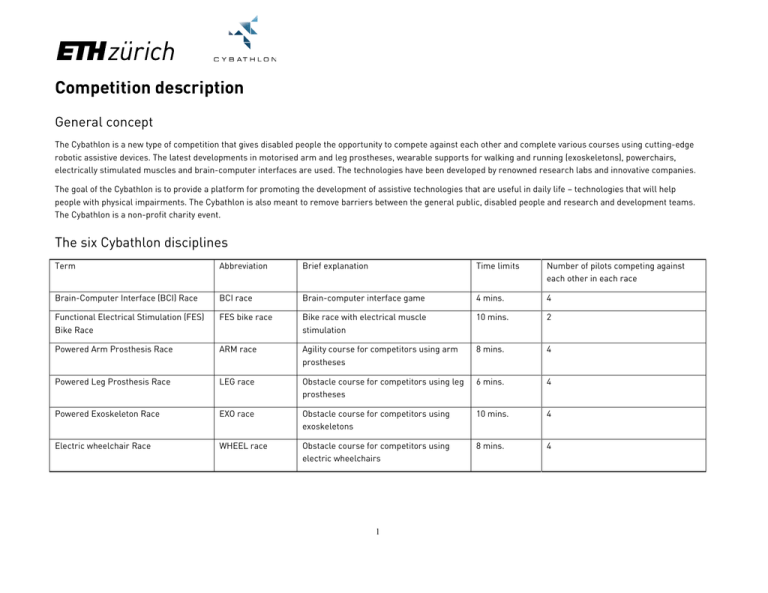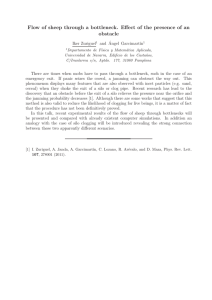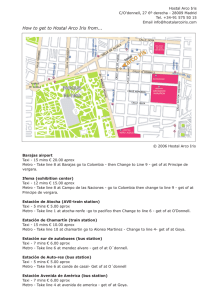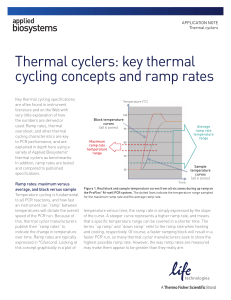Competition description
Anuncio

Competition description General concept The Cybathlon is a new type of competition that gives disabled people the opportunity to compete against each other and complete various courses using cutting-edge robotic assistive devices. The latest developments in motorised arm and leg prostheses, wearable supports for walking and running (exoskeletons), powerchairs, electrically stimulated muscles and brain-computer interfaces are used. The technologies have been developed by renowned research labs and innovative companies. The goal of the Cybathlon is to provide a platform for promoting the development of assistive technologies that are useful in daily life – technologies that will help people with physical impairments. The Cybathlon is also meant to remove barriers between the general public, disabled people and research and development teams. The Cybathlon is a non-profit charity event. The six Cybathlon disciplines Term Abbreviation Brief explanation Time limits Number of pilots competing against each other in each race Brain-Computer Interface (BCI) Race BCI race Brain-computer interface game 4 mins. 4 Functional Electrical Stimulation (FES) Bike Race FES bike race Bike race with electrical muscle stimulation 10 mins. 2 Powered Arm Prosthesis Race ARM race Agility course for competitors using arm prostheses 8 mins. 4 Powered Leg Prosthesis Race LEG race Obstacle course for competitors using leg prostheses 6 mins. 4 Powered Exoskeleton Race EXO race Obstacle course for competitors using exoskeletons 10 mins. 4 Electric wheelchair Race WHEEL race Obstacle course for competitors using electric wheelchairs 8 mins. 4 1 Overview of the field (example of 4 lanes for leg-prosthesis obstacle course) 2 BCI race: brain-computer interface game In the BCI race, pilots with severe paralysis use their thoughts to control an avatar in a computer game. Brainwaves are recorded and transmitted to the computer game via a brain-computer interface. The challenge here lies in correctly transmitting the thoughts. Up to three different brain signals can be used to control the avatar in the game. If the correct brain signal is received at the correct moment, i.e. when the avatar enters a designated zone, the avatar can perform certain actions: 1) SPEED: the avatar speeds up 2) JUMP: the avatar jumps over spikes 3) ROLL: the avatar rolls under the “dangerous rays” If the computer receives the wrong brain signal or the right signal at the wrong moment, the avatar stumbles. The idea is that this method could be used to control devices such as electric wheelchairs in the future. Time limit 4 mins. Scoring The first to reach the finish is the winner. If the competitor has not reached the finish within the time limit, the distance travelled will be counted. 3 FES bike race: bike race with electrical muscle stimulation Pilots with complete paraplegia ride in a bike race using functional electrical stimulation of their muscles. The nerve pathways controlling these competitors’ leg muscles are interrupted. By externally attaching electrodes to the legs, it is possible to send electrical impulses to the muscles, thereby causing the muscles to contract. The pilots can often stimulate the muscles themselves using a controller. The challenge is to stimulate the muscles skilfully in such a way that the driver is fast but does not become fatigued. The bike is not motorised. The idea of the FES bike is to stimulate physical functions and locomotion in daily life and leisure time. Time limit 10 mins. Wertungsschlüssel 1) The first to reach the finish is the winner. 2) If a competitor has not reached the finish within ten minutes, the distance travelled is counted (half-lap increments). 3) If two pilots complete the same number of half-laps, the faster person wins. 4 ARM race: agility course for competitors with arm prostheses Pilots with upper-arm amputations use motorised arm prostheses to complete physical challenges quickly and with precision. The challenge lies in the variety of the tasks, which require different kinds of grips and movements. The prostheses must be able to execute these movements, and the pilots must initiate the movements correctly. The idea is that well-designed prostheses should enable a complex range of motion and eliminate compensating movements in daily life, in turn offering the wearer more comfort and resulting in less secondary damage or injury. Main competition rules • • • Blue objects may only be moved and manipulated with the arm prostheses. There are no restrictions for any of the other objects. The competitor may skip certain challenges, but these challenges cannot be repeated later. Once a challenge has been completed, the light turns green. The light turns red if the challenge is not completed or is completed incorrectly. Time limit 8 mins. Challenge Points Puzzle: various blue grips 2 Buzz wire game Setting the table: carrying small kitchen objectson a tray, starting from a shelf and going through a door 4 Preparing a meal: opening cans, cutting bread 15 30 Scoring 1) Whoever completes the most challenges wins. 2) Whoever completes more difficult challenges (collects the most points) wins. 3) Whoever completes the challenges faster wins. 5 Hanging up laundry (letters) with blue clothes pins 8 Carrying large objects 1 LEG race: obstacle course for competitors with leg prostheses Pilots with leg amputations use a motorised leg prostheses to complete an exciting obstacle course with challenges relevant to daily life. The challenge lies in the variety of the tasks, which require various steps and movements. The prostheses must be able to execute these movement, and the pilots must initiate the movements correctly. The idea is that good prostheses make it possible to overcome any obstacle in daily life, without compensatory movements or premature fatigue Main competition rules • • The competitor may skip certain challenges, but these challenges cannot be repeated later. Once a challenge has been completed, the light turns green. The light turns red if the challenge is not completed or is completed incorrectly. Time limit 6 mins. Challenge Points Sofa: sitting down and standing up 5 times 1 Beam: balancing Ramp and door: walking up and down a steep ramp, opening and closing doors 2 Stones: stepping over stones with precise movements 4 8 Scoring 1) Whoever completes the most challenges wins. 2) Whoever completes more difficult challenges (collects the most points) wins. 3) Whoever completes the challenges faster wins. 6 Tilted ramp: mastering a tilted ramp 15 Steps: going up and down a set of steps 3 times 30 EXO race: obstacle course for competitors using exoskeletons Pilots with complete paraplegia use a motorised support (exoskeleton) to complete an exciting obstacle course with challenges relevant to daily life. The challenge lies in the variety of the tasks, which require various steps and movements. The exoskeleton must be able to complete these movements, and the pilot must initiate the movements correctly. The idea is that a well-designed exoskeleton makes it possible to overcome any obstacle in daily life, so that a person's mobility is not restricted. Main competition rules • • The contestant may skip certain challenges, but these challenge cannot be repeated later. Once a challenge has been completed, the light turns green. The light turns red if the challenge is not completed or is completed incorrectly. Time limit 10 mins. Challenge Points Sofa: sitting down and standing up once 1 Beam: balancing Ramp and door: going up and down a steep ramp, opening and closing a door 2 Stones: stepping over stones with precise movements 4 8 Scoring 1) Whoever completes the most challenges wins. 2) Whoever completes more difficult challenges (collects the most points) wins. 3) Whoever completes the challenges faster wins. 7 Tilted ramp: mastering a tilted ramp 15 Steps: going up and down a set of steps once 30 WHEEL race: obstacle course for wheelchairs Pilots with limited mobility control an electric wheelchair to complete an exciting obstacle course with challenges relevant to daily life. The challenge lies in the variety of the tasks, which require agility in controlling the wheelchair. In order to tackle obstacles such as ramps, steps and slalom courses, the wheelchair must be easy to control as well as manoeuvrable, small and strong. The idea is that good wheelchairs make it possible to overcome various types of obstacles in everyday life. Main competition rules • • The contestant may skip certain challenges. However, these challenges cannot be repeated later. Once a challenge has been completed, the light turns green. The light turns red if the challenge is not completed or is completed incorrectly. Time limit 8 mins. Challenge Points Table: approaching and moving away 1 Slalom: passing through Ramp and door: going up and down a ramp, opening and closing a door 2 Stones: battling “cobblestones” 4 8 Scoring 1) Whoever completes the most challenges wins. 2) Whoever completes more difficult challenges (collects the most points) wins. 3) Whoever completes the challenges faster wins. 8 Tilted ramp: mastering a tilted ramp 15 Steps: going up and down a set of steps once 30



